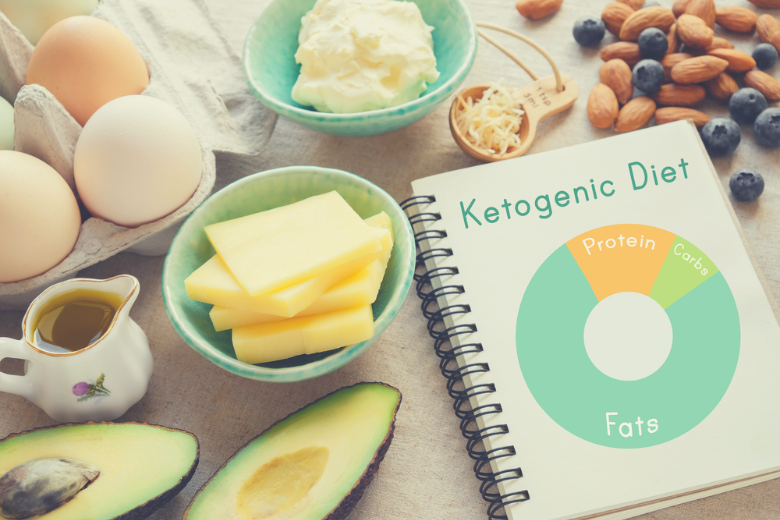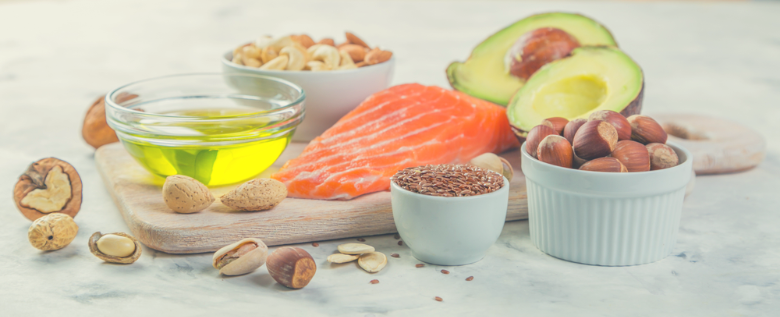A little over a year ago, my doctor diagnosed me with Type II diabetes.
She also told me that I needed to lose weight in order to bring my blood sugar under control and avoid the complications that accompany uncontrolled diabetes.
She strongly warned me to limit my intake of carbohydrates for the same reason. One way I was able to accomplish this was with the keto diet.
What Is the Keto Diet?
The keto diet, which is more formally called the ketogenic diet, is a medical or therapeutic diet.
It was originally developed back in the 1920s as a therapy for children with uncontrolled epilepsy.
It eventually fell out of fashion for a while as new and more effective anticonvulsant medications were developed.
Doctors, however, revived the diet after discovering that the new drugs didn’t work on everybody.
There were still patients with resistant epilepsy, and the ketogenic diet could help them.
Over the decades, doctors have developed five variations of the ketogenic diet: original or classic, modified keto, MCT (Medium Chain Triglycerides), Low Glycemic, and Modified Atkins.
The differences between the five diets are their macronutrient ratio or the amount of fat compared to the number of carbohydrates and proteins.
Classic Keto, which is the strictest form of the diet, has a 4:1 ratio, which means you eat four parts of fat for every one part of carbohydrate and protein combined.
Since fat has more calories than the other two macronutrients, this means 90 percent of the calories would come from fat, while 6 percent would come from proteins, and 4 percent would come from carbohydrates.
While the other ketogenic diets reduced the amount of fat consumed, they are still high-fat and low-carbohydrate diets.
The Low Glycemic diet, which is the least strict variation, calls for a diet that is 60 percent fat, 30 percent protein, and 10 percent carbohydrates.
This gives it a 2:3 macronutrient ratio.
In addition to following the given macronutrient ratio, you would take supplements and electrolytes.
You would also need to stay hydrated and follow an exercise regime. Some people also periodically fast.
Who Is the Keto Diet for?
As already mentioned, the ketogenic diet can help people with uncontrolled epilepsy, and it is particularly beneficial for children.
The different ketogenic diets have also been used to treat patients with Alzheimer’s disease and some types of cancer.
They have also helped people with various metabolic or neurological disorders.
In 2018, the science journal “Diabetes Therapy” described a year-long study in which the researchers put 349 patients with Type II diabetes on the ketogenic diet.
They recorded their weight, blood sugar levels, and other vitals at the beginning of the study and tracked them throughout the study.
By the end, the participants had lost an average of 30 pounds. They also needed fewer medications, and many no longer needed insulin injections.
The researchers called the results promising but acknowledged that further studies with larger and more diverse samples would be needed before they could confidently recommend the ketogenic diet as a therapy for patients with Type II diabetes.
It is also worth noting that the patients worked with their doctors during the study.
The ketogenic diet can also help people who are morbidly obese, which is defined as having a BMI of 40 or over.
It can help such patients reset their metabolism so they can lose weight more readily. The keto diet may also help patients with autism or glioblastoma and other brain cancers.

What Is Ketosis?
Ketosis is a metabolic process that occurs when the body doesn’t have enough glucose to use for fuel. Under normal conditions, the body converts carbohydrates into the needed glucose.
If your body doesn’t have enough carbohydrates or glucose, however, it will start to burn accumulated fat instead.
Fat can take the form of single fatty acids or chains of fatty acids called triglycerides that consist of three fatty acids linked by a compound called glycerol.
Triglycerides are too large to move across cell walls and thus become stored fat.
During ketosis, the body breaks down the triglycerides and produces glucose from glycerol.
The metabolic process produces ketones as a side effect, and the body will eventually excrete ketones in urine.
The ketogenic diet deliberately tries to induce ketosis by restricting the amount of carbohydrates in a person’s diet, while encouraging them to eat lots of fat.
The ketogenic diet deliberately tries to induce ketosis in order to take advantage of its therapeutic effects.
What Are the Health Benefits of the Keto Diet?
The health benefits of the ketogenic diet can include the following:
- Faster metabolism
- Increased muscle mass
- Decreased hunger
- Lowered blood pressure
- Decreased risk of heart disease
The ketogenic diet can also reduce the risks of developing metabolic syndrome and diabetes.
It may increase levels of high-density lipoprotein (HDL or “good cholesterol”) more effectively than do other low-carb diets.
Such benefits, however, may be due to weight loss and the addition of more healthful foods to a person’s diet, than to the decreased consumption of carbohydrates.
The ketogenic diet has long been used to help children with uncontrolled epilepsy by reducing the number of seizures they have.
Researchers have been studying the possibility of using the diet to help adults with epilepsy.
Similarly, they have been researching the possibility of using the diet as a therapy for patients with polycystic ovary disease, Lou Gehrig’s disease, some types of cancer, Alzheimer’s disease, and acne.
The ketogenic diet can also help people with Type II diabetes.
Patients with this disorder do produce some insulin, but they either don’t produce enough of it or it doesn’t work as effectively as it should. In both cases, their body can’t process glucose efficiently, so their blood sugar levels become abnormally high.
A low-carb diet like the ketogenic diet lowers the blood sugar levels by reducing the amount of glucose in the patient’s body.
How to Get Started With the Keto Diet
The first step is to consult a doctor and get their advice.
The ketogenic diet works best when under the guidance of a knowledgeable medical professional, who can recommend the most appropriate variation.
The ketogenic diet can involve intermittent fasting, and the doctor can advise you on the way to do that safely and effectively.
You may also want to talk to a nutritionist. The keto diet greatly limits the amount of vegetables, fruits, whole grains, and dairy products you can eat, as they all contain a lot of carbohydrates.
That increases the risk of developing a nutritional deficiency. A nutritionist will thus advise you on what supplements you need to take to prevent that from happening.
Since the ketogenic diet involves drastic changes in eating habits, it might be best to ease into it. Most people, for example, eat a lot of carbohydrates.
By contrast, if you’re on the keto diet, you will be eating anywhere from 60 to 90 percent fat.
Most people will need to eat 20 to 50 grams of net carbs every day with “net carbs” being defined as total carbs minus fiber.
The amount of protein will depend on your body weight. A rule of thumb is that you should eat 1 gram of protein for every kilogram of body weight.
If you weigh 140 pounds, or about 64 kilograms, for example, you should eat 64 grams of protein every day.
Rather than make drastic changes all at once, you can make small changes working toward the desired macronutrient ration.
For example, if you like hamburgers, you can eat it on lettuce leaves rather than bread. Similarly, you could substitute green vegetables for French fries.
You should also cook with more oils like olive oil or avocado oil to increase the fat content in your diet. As you replace carbohydrates with fats, you will move to a fully ketogenic diet.
You will also need to cook your meals since most processed foods are high in carbohydrates.
Fortunately, there are many cookbooks and websites devoted to the ketogenic diet.
Pick several recipes that include your favorite foods, so you aren’t tempted to backslide and revert to eating carbs.
When shopping for food, you will need to check the ingredients labels.
For example, while meat is generally safe, some cold cuts have added sugar and should thus be avoided.
Similarly, mayonnaise can be sugar-free or contain sugar. You will need to check the label to make sure you are getting a sugar-free variety.
Foods to Eat
With all of that in mind, here are lists of foods to eat and to avoid:
Protein
Eat liberally:
- Fish, particularly fatty fish, such as salmon
- Dark meat chicken
- Grass-fed beef
- Eggs
- New York Strip steak
Eat in moderation:
- Low-fat proteins like shrimp or skinless chicken breast, served with a sauce to increase the fat content
- Bacon
Fat and Oil
Use liberally:
- Butter
- Avocado oil
- Coconut oil
- Heavy cream
- Olive oil
Use in moderation:
- Corn oil
- Safflower oil
- Sunflower oil
Seeds and Nuts
Eat liberally:
- Almonds
- Chia seeds
- Flax seeds
- Walnuts
- Pecans
- Brazil nuts
- Macadamia nuts
Eat in moderation:
- Cashews
- Pistachios
- Unsweetened nut butter like peanut butter

Fruits and Vegetables
Eat liberally:
- Asparagus
- Avocado
- Celery
- Leafy greens, like arugula or spinach
- Cucumber
- Green pepper
- Zucchini
- Mushrooms
- Raspberries
- Blackberries
- Strawberries
- Cantaloupe
Eat in moderation:
- Eggplant
- Leeks
- Spaghetti squash
- Tomato
- Green beans
- Olives
- Blueberries
- Kiwis
- Pears
- Apples
Dairy Products
Eat liberally:
- Blue cheese
- Cheddar cheese
- Feta cheese
Eat in moderation:
- Full-fat ricotta cheese
- Full-fat plain Greek yogurt
- Full-fat cottage cheese
Sweeteners
Use in moderation:
- Erythritol
- Stevia
- Xylitol
Sauces and Condiments
Use liberally:
- Mayonnaise with no added sugar
- Lemon butter sauce
- Guacamole
- Bearnaise sauce
- Tabasco or hot sauce
Use in moderation:
- Tomato sauce with no added sugar
- Raw garlic
- Balsamic vinegar
- Garlic butter
- Soy sauce
Spices
Use liberally:
- Thyme
- Salt
- Pepper
- Paprika
- Oregano
- Cayenne
Use in moderation:
- Onion powder
- Ground ginger
- Garlic powder
Beverages
Drink liberally:
- Almond milk
- Bone broth
- Plain tea
- Water
Drink in moderation:
- Zero-calorie drinks
- Unsweetened carbonated water
- Diet soda
- Black coffee
- Wine
Foods to Avoid
Protein
- Chicken or fish nuggets
- Meat that has been marinated in sugary sauces
- Cold cuts with added sugar
Fat and Oil
- Artificial trans fats
- Margarine
Seeds and Nuts
- Chocolate-covered nuts
- Sweetened nut or seed butter
- Trail mixes with dried fruit
Fruits and Vegetables
- Corn
- Potatoes
- Raisins
- Sweet potatoes
- Quinoa
- Baked beans
- Lentils
- Peas
- Bananas
Dairy Products
- Ice cream
- Milk
- Sweetened nonfat yogurt
Grain Products
- Rice
- Bread
- Doughnut
- Pasta
Sweeteners
- White sugar
- Maple syrup
- Honey
- Brown sugar
- Agave
Sauces and Condiments
- Ketchup
- Honey mustard
- Barbecue sauce
- Jam
Beverages
- Fruit juice
- Lemonade
- Soda
- Smoothie
- Milkshake
- Iced tea
- Energy drink
Side Effects and Concerns
The best-known and most common side effect is the so-called “keto flu.”
It happens during the first week or two of the ketogenic diet and is caused by the body’s shifting from a carbohydrate-burning diet to the ketogenic diet.
The severity of the keto flu can vary; some people have very little trouble, while others are miserable. A person with the keto flu will be very lethargic:
Even walking up the stairs will seem impossible. They may also have mental fog impairing their ability to concentrate or remember.
The ketogenic diet does require a change in the amount of fiber a person eats. Consequently, many people experience diarrhea or constipation as their body adjusts to that change.
During ketosis, the kidneys will excrete more electrolytes and water than normal. You will thus have to stay hydrated.
You will also need to make sure that your body is getting the chloride and sodium that it needs. You will thus have to increase your salt intake.
In addition to adding salt to your food, you may want to eat non-starchy vegetables like kale or asparagus and drink salted bone broth.
The ketogenic diet is not for everybody.
People who are already on restrictive diets, like vegans and people with food allergies or intolerances may find the ketogenic diet’s added restrictions difficult to handle.
They may struggle more than most to maintain good nutrition.
People with certain medical conditions should either avoid the ketogenic diet or have a long talk with their doctor before trying it.
Examples of such conditions high blood pressure, high cholesterol, and GI tract problems.
While patients with Type II diabetes can successfully use the ketogenic diet, patients with Type I diabetes risk developing a dangerous condition called ketoacidosis in which too many ketones accumulate within the body and cause a form of poisoning resulting from abnormally acidic blood.
Symptoms of ketoacidosis can include the following:
- Fruity breath
- Abdominal pain
- Frequent urination
- Nausea and vomiting
- Dry mouth and excessive thirst
- Rapid breathing or shortness of breath
- Flushed or dry skin
Since ketoacidosis can develop within a day, patients with Type I diabetes will have to carefully monitor their ketone levels by testing themselves at least three times a day.
They should also consult a specialist about the amount of insulin they need to take.
Summary
The keto diet can help people lose weight, and it can improve the health of people with certain conditions.
It is a strict diet that greatly limits people’s dietary choices, however, so you should not attempt it without discussing it with your doctor first.
Since the ketogenic diet is so restrictive, people often use it for a limited time before easing into a healthy diet that allows them to eat more of their favorite foods.




